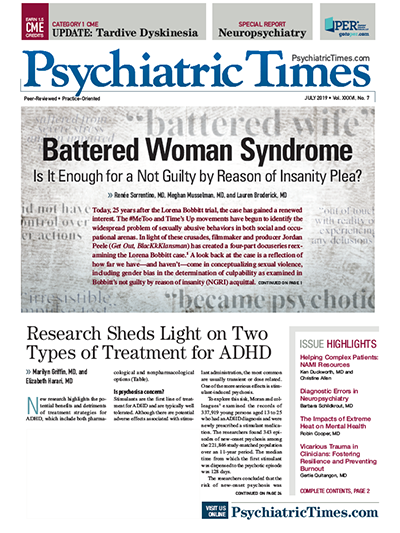Identification, Assessment, and Clinical Management of Tardive Dyskinesia: An Update
This CME discusses what is known about the pathology of tardive dyskinesia, the risk factors for the disorder, assessment of patients with movement disorders, and diagnosis and treatment.
Table 1. Medications associated with or that can worsen tardive dyskinesia
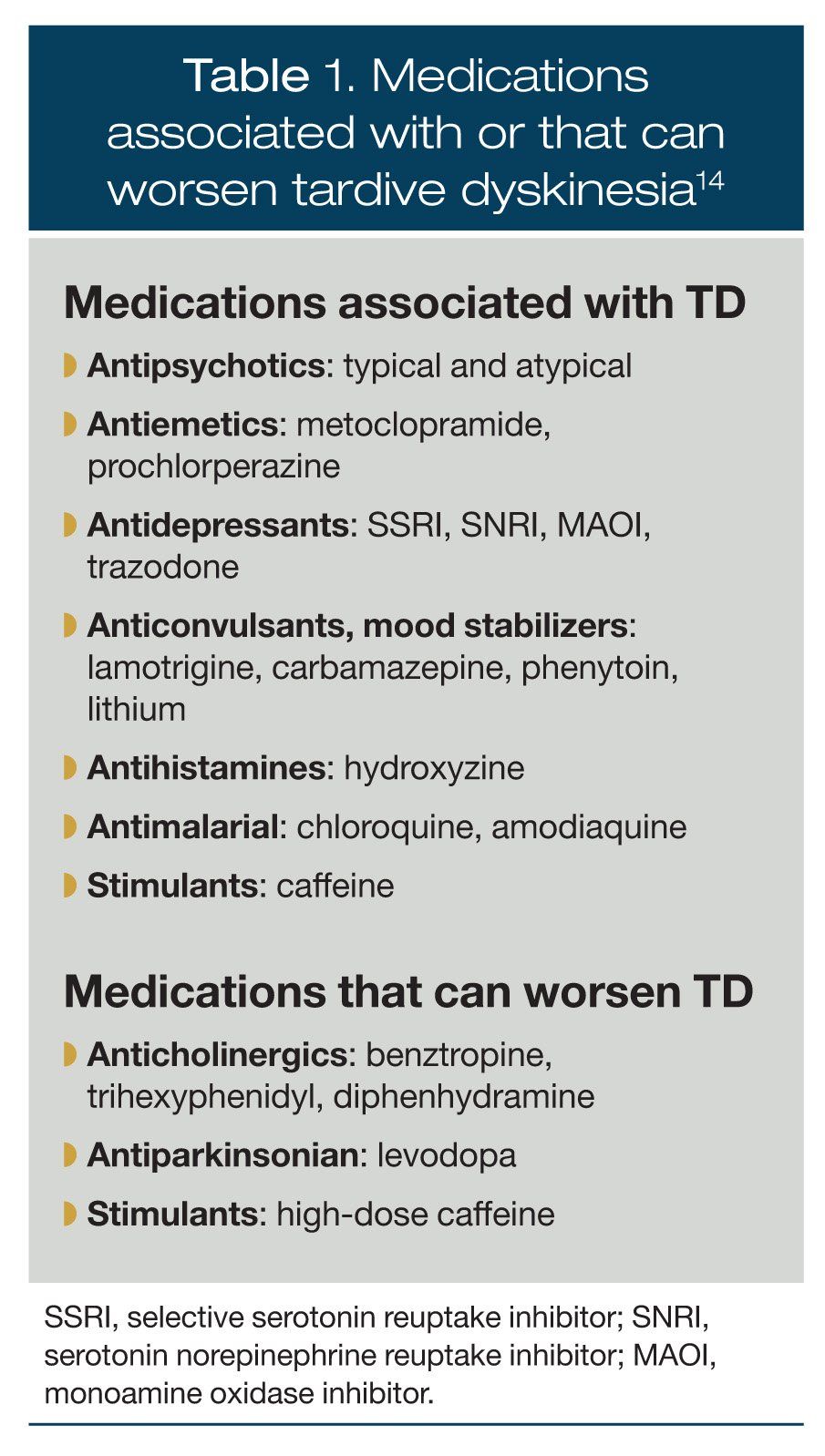
Table 2. Risk factors for tardive dyskinesia

Premiere Date: July 20, 2019
Expiration Date: January 20, 2021
This activity offers CE credits for:
1. Physicians (CME)
2. Other
All other clinicians either will receive a CME Attendance Certificate or may choose any of the types of CE credit being offered.
ACTIVITY GOAL
The goal of this activity is to provide a comprehensive understanding for the identification, assessment, and clinical management of tardive dyskinesia.
LEARNING OBJECTIVES
At the end of this CE activity, participants should be able to:
• Discuss what is known about the pathology of tardive dyskinesia as well as the risk factors for the disorder
• Assess a patient with movement disorder and make a diagnosis
• Identify FDA-approved pharmacotherapies for tardive dyskinesia
TARGET AUDIENCE
This continuing medical education activity is intended for psychiatrists, psychologists, primary care physicians, physician assistants, nurse practitioners, and other health care professionals who seek to improve their care for patients with mental health disorders.
CREDIT INFORMATION
CME Credit (Physicians): This activity has been planned and implemented in accordance with the Essential Areas and policies of the Accreditation Council for Continuing Medical Education (ACCME) through the joint providership of CME Outfitters, LLC, and Psychiatric Times. CME Outfitters, LLC, is accredited by the ACCME to provide continuing medical education for physicians.
CME Outfitters designates this enduring material for a maximum of 1.5 AMA PRA Category 1 Credit™. Physicians should claim only the credit commensurate with the extent of their participation in the activity.
Note to Nurse Practitioners and Physician Assistants: AANPCP and AAPA accept certificates of participation for educational activities certified for AMA PRA Category 1 Credit™.
DISCLOSURE DECLARATION
It is the policy of CME Outfitters, LLC, to ensure independence, balance, objectivity, and scientific rigor and integrity in all of their CME/CE activities. Faculty must disclose to the participants any relationships with commercial companies whose products or devices may be mentioned in faculty presentations, or with the commercial supporter of this CME/CE activity. CME Outfitters, LLC, has evaluated, identified, and attempted to resolve any potential conflicts of interest through a rigorous content validation procedure, use of evidence-based data/research, and a multidisciplinary peer-review process.
The following information is for participant information only. It is not assumed that these relationships will have a negative impact on the presentations.
Melissa Palmer, PharmD, has no disclosures to report.
Austin R. Campbell, PharmD, reports that he is on the Speakers Bureau of Sunovion Pharmaceuticals.
Amber Finegan, PharmD, has no disclosures to report.
Leigh Anne Nelson, PharmD, reports that she has received research support from Neurocrine Biosciences and Teva Neuroscience; her husband is a shareholder in Neurocrine Biosciences.
Vivek Datta, MD (peer/content reviewer), has no disclosures to report.
Applicable Psychiatric Times staff and CME Outfitters staff have no disclosures to report.
UNLABELED USE DISCLOSURE
Faculty of this CME/CE activity may include discussion of products or devices that are not currently labeled for use by the FDA. The faculty have been informed of their responsibility to disclose to the audience if they will be discussing off-label or investigational uses (any uses not approved by the FDA) of products or devices. CME Outfitters, LLC, and the faculty do not endorse the use of any product outside of the FDA-labeled indications. Medical professionals should not utilize the procedures, products, or diagnosis techniques discussed during this activity without evaluation of their patient for contraindications or dangers of use.
For content-related questions, email us at PTeditor@mmhgroup.com; for questions concerning CME credit call us at 877.CME.PROS (877.263.7767)
The most common movements associated with tardive dyskinesia (TD) are in the oral regions and include puckering, chewing, grimacing, and tongue protrusions. It is also common to see choreiform movements of the extremities, such as “piano playing” movements of the fingers.
Although other medications may be associated with TD, it is most often noted in patients treated with either typical or atypical antipsychotics, especially at higher doses. TD can be caused by additional medications that are dopamine D2 receptor antagonists, such as metoclopramide used in the treatment of gastrointestinal disorders. A list of medications with reports of associated TD and medications that can worsen TD are described in Table 1.
Pathophysiology
Although TD was identified over 50 years ago, its pathophysiology remains poorly elucidated and is likely multifactorial and complex. The most prominent theory involves postsynaptic dopamine D2 receptor upregulation with associated dopamine receptor supersensitivity due to chronic exposure to dopamine D2 receptor antagonists. This theory is supported by:
• Worsening of TD symptoms when the offending medication antagonizing dopamine receptors is discontinued
• Temporary improvement of symptoms seen upon increasing the dose of the offending medication
This theory can be challenged by the fact that TD may be irreversible in some cases when the offending medication is discontinued, even though downregulation of dopamine receptors would be expected. Neurotransmitter dysregulation and abnormalities in the striatal gamma-aminobutyric acid (GABA) neurons responsible for synaptic plasticity resulting in GABAergic hypofunction and degeneration of striatal cholinergic interneurons have been theorized as causes of TD. Glutamate and opioid neurotransmitter dysregulation has also been implicated. Another popular theory is the “neurodegenerative hypothesis” that suggests that medications that antagonize the dopamine D2 receptor increase lipid peroxidation and free radical formation leading to neuronal degeneration, damage, and structural changes in the brain. There is conflicting evidence for all of these theories, and the pathophysiology of TD remains poorly understood.
The risk for TD is significantly lower with atypical antipsychotics; the lowest risk is for patients who have never been treated with typical antipsychotics. A list of well-established risk factors for TD can be found in Table 2.
Table 3.
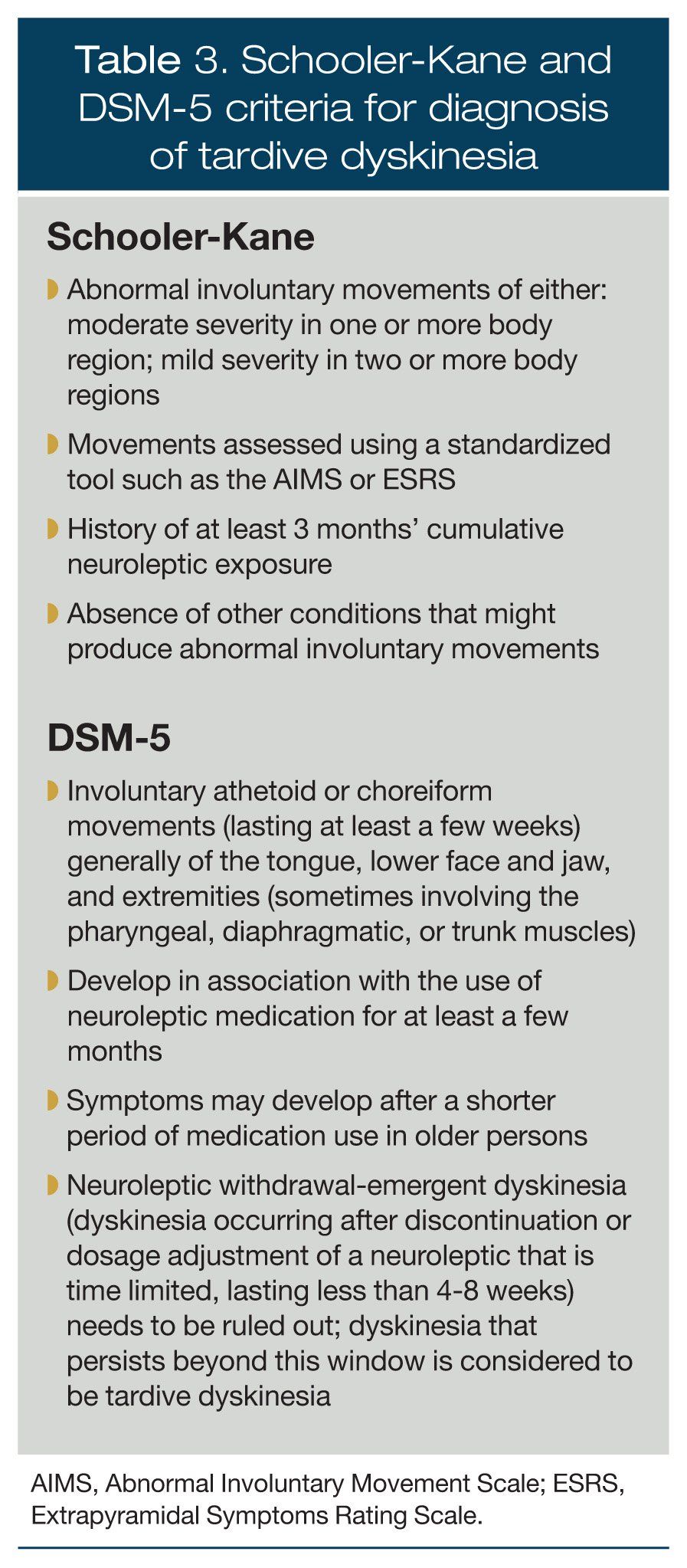
Table 4. Tardive dyskinesia prevention and harm reduction strategies

Diagnosis
When a patient presents with involuntary, repetitive movements, differential diagnoses must be considered including tics, drug-induced parkinsonism, tardive syndromes, and other neurological causes. Table 3 describes the diagnostic criteria for TD based on DSM-5 and the Schooler-Kane Research Criteria.1 Although TD is irreversible in many cases, the manner and acuity of the movements can fluctuate over time.
Strategies for prevention
A number of preventive measures have been suggested to reduce TD risk. Patient and/or caregiver risk-prevention education is imperative before initiation of antipsychotic therapy. To minimize risk it is recommended to adhere to antipsychotic prescribing information regarding appropriate indications and dosing; avoid off-label use if possible. If dyskinesias are noted, consider an atypical antipsychotic with a lower risk of TD. Alternatively, a dose reduction of the antipsychotic can be considered.
In general, use the lowest effective dose for the shortest possible duration, particularly in the elderly. Keep in mind ongoing use with other medications that are dopamine D2 receptor antagonists (eg, metoclopramide, prochlorperazine). Use of these medications in combination with antipsychotics should be avoided. Regularly assess all patients chronically taking medications that antagonize the dopamine D2 receptor for any abnormal movements with the Abnormal Involuntary Movement Scale (AIMS).2Table 4 summarizes TD prevention strategies.
Monitoring/assessment tools
The American Psychiatric Association (APA) recommends that all patients treated with an antipsychotic be regularly monitored for abnormal movements.3 Assess patients treated with a typical antipsychotic every 6 months; assess patients treated with atypical antipsychotics every 12 months. Consider more frequent monitoring for patients with TD or those who have TD risk factors (eg, every 3 months).
The AIMS was developed by the National Institute of Mental Health. It is widely used in clinical practice because it can be administered by any qualified health care professional-the examination and scoring procedures are explained in detail, and it takes approximately 10 minutes to administer.
The 12-item assessment includes 10 items ranked on a 5-point scale from 0 to 4 that increase in severity (none, minimal, mild, moderate, severe). Various areas of the body are examined including a global assessment of severity and patient awareness of any abnormal movements. The last two items address any potential problems a patient currently has with his or her teeth and/or dentures that could affect assessment results.
Early recognition of abnormal movements is imperative to management of TD symptoms. Clinical utility of a movement disorder scale such as the AIMS can lead to timely identification and thus, improved outcomes.
Table 5. Evidence-based treatments for tardive dyskinesia
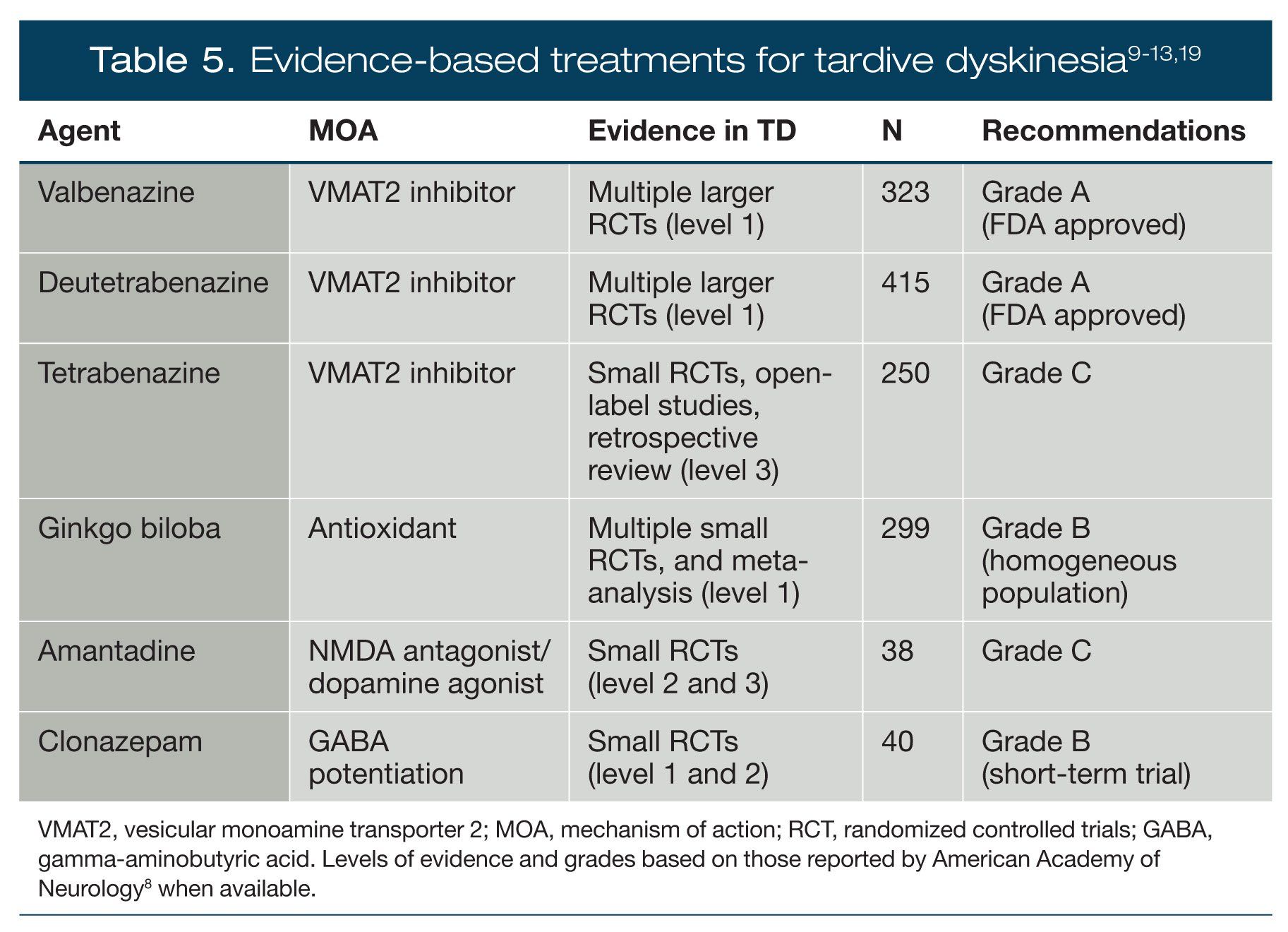
Table 6. Comparison of FDA-approved treatments for tardive dyskinesia
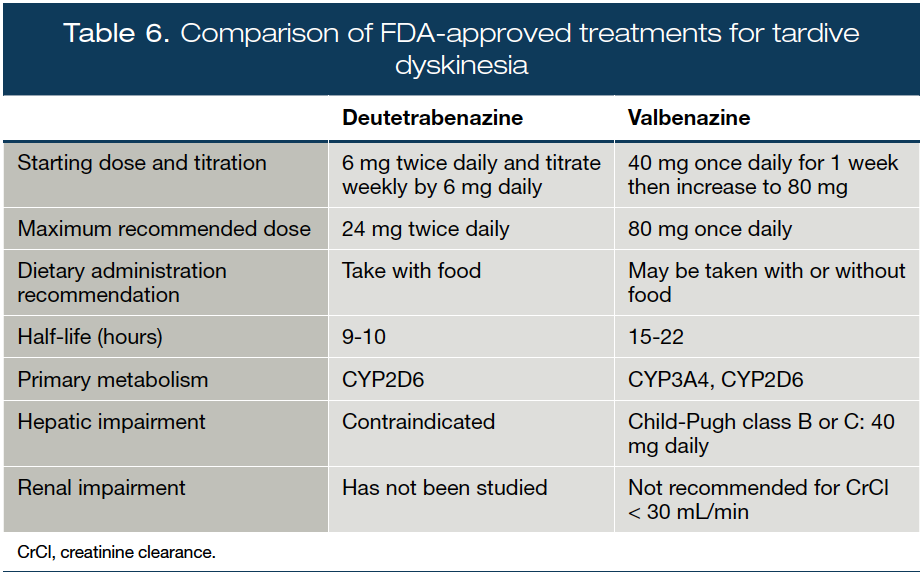
Treatment strategies
Traditionally, the following are first steps in managing newly diagnosed TD:
1) Gradually taper the dose of the offending agent to reduce the risk of antipsychotic withdrawal dyskinesias.
2) Transition the patient from typical to atypical antipsychotic (other than clozapine), when applicable.
3) Discontinue anticholinergic medications.
In instances where an atypical antipsychotic is the causative agent, consider transitioning to a different atypical antipsychotic with lower risk for TD such as clozapine, olanzapine, or quetiapine. In addition to these standard approaches, there exists a myriad of additional treatment options with a variety of proposed mechanisms and varying levels of evidence. Treatment options considered to have at least a moderate level of evidence for use are reviewed in Table 5; see Table 6 for a comparison of FDA-approved treatments for TD.
Ginkgo biloba
The benefits of ginkgo biloba in the treatment of TD are attributed to its antioxidant effects and possible free-radical scavenging. In an effort to compare ginkgo biloba extract with placebo, Zheng and colleagues4 undertook a meta-analysis of three 12-week randomized controlled trials in 299 Chinese patients with schizophrenia. Patients taking ginkgo biloba experienced a 2.3 point reduction on AIMS total score; the discontinuation rates were similar to those for placebo. While it appears somewhat effective and well tolerated, more studies are needed in non-Chinese populations before the results can be extrapolated to the general population.
Amantadine
Amantadine is an anti-Parkinson disease medication that is a noncompetitive N-methyl-D-aspartate (NMDA) receptor antagonist and dopamine agonist that is FDA approved for the treatment of drug-induced extrapyramidal symptoms. While its use in managing Parkinson disease-related dyskinesias has been established, evidence for use in TD is much more limited.5
In a randomized double-blind controlled trial, 22 patients were treated with up to 400-mg amantadine or placebo for 2 weeks.6 The amantadine group experienced a 3 point (22%) reduction on AIMS total score. These results duplicate the findings of an earlier study by Angus and colleagues,7 whose findings showed a 15% mean reduction in AIMS scores. Despite these results, the use of amantadine remains somewhat contentious because of the overall paucity of evidence specific to TD and the potential to worsen psychosis.
Clonazepam
Like all benzodiazepines, clonazepam potentiates the inhibitory effects of GABA, which may be of value in some patients with TD. Several small studies have shown short-term benefit of clonazepam in reducing dyskinetic movements associated with TD.8 However, due to the limitations of these trials, the development of tolerance in some study subjects, as well as general concerns for adverse effects, abuse, and dependence, clonazepam is not a first-line treatment for TD.
Tetrabenazine
Tetrabenazine, the first vesicular monoamine transporter 2 (VMAT2) inhibitor, is FDA approved for the treatment of chorea in Huntington disease. The drug’s benefits in TD are attributed to its reduction of synaptic monoamines, particularly dopamine, reducing neuronal stimulation and hyperactivity. A more recent review of the evidence for tetrabenazine in TD yielded a series of four open-label studies, two small randomized controlled trials, and two retrospective reviews.8 The results of these trials demonstrated a consistent improvement in TD symptoms in 41% to 100% of participants-the majority of studies showed moderate or better improvement. While these results are encouraging, tetrabenazine has several limitations associated with its use. The medication’s short half-life necessitates 2 to 3 times daily dosing, while adverse effects such as somnolence, parkinsonism, and akathisia limit dose titration and tolerability. The medication also carries a boxed warning for depression and suicide risk.
Deutetrabenazine
While similar to its parent compound, deutetrabenazine incorporates deuterium onto the primary site of drug metabolism. This minor structural change yields an increased half-life and lower Cmax, translating to less frequent dosing and improved tolerability. Like tetrabenazine, deutetrabenazine carries an indication for treatment of chorea associated with Huntington disease; however, in August 2017 it became the second drug to receive FDA approval for treatment of TD. The evidence behind this approval comes primarily from two larger-scale, 12-week, randomized, double-blind, placebo-controlled studies.
The first study evaluated the tolerability, safety, and efficacy of deutetrabenazine in 117 patient with TD.9 Patients were initiated on 6 mg twice daily and titrated according to clinical response. By the end of the study period, the deutetrabenazine group experienced a least-squares mean change from baseline of -3.0 points on the AIMS. Moreover, patients taking deutetrabenazine experienced fewer psychiatric adverse events and had lower rates of discontinuation compared with placebo.
The second study included 298 patients randomized to receive placebo or deutetrabenazine 12 mg, 24 mg, or 36 mg daily in divided doses.10 Patients who received the 24 mg and 36 mg daily doses experienced significantly greater reductions in AIMS scores; one-third of these patients had a 50% or greater reduction of symptoms. Furthermore, rates of discontinuation and psychiatric adverse effects were low.
Valbenazine
In April 2017, valbenazine became the first FDA-approved treatment for TD. Another VMAT2 inhibitor, valbenazine and its two active metabolites are all highly selective reversible binders. The safety and efficacy of valbenazine was determined from four randomized double-blind placebo-controlled trials and one long-term open-label extension study.11 While smaller-dose finding studies did not separate from placebo, two larger 6-week trials demonstrated significant improvements in AIMS total scores.
The first study randomized 89 patients with moderate to severe TD to placebo or 25-mg valbenazine daily, which could be increased by 25 mg daily every 2 weeks up to 75 mg daily.12 The least-squares mean change in AIMS scores from baseline was -2.6 for valbenazine and -0.2 for placebo, with roughly one-half of patients experiencing a 50% or greater reduction in AIMS total scores. Of note, 76% of patients reached 75 mg daily; there were no discontinuations due to adverse events.
The second study was a randomized, double-blind, fixed dose study that compared placebo with either 40-mg or 80-mg valbenazine in 234 patients.13 At the end of 6 weeks both valbenazine treatment groups experienced significant reductions in AIMS scores. The least-squares mean changes from baseline were -3.2 for valbenazine 80 mg, -1.9 for valbenazine 40 mg, and -0.1 for placebo. A greater than 50% reduction in AIMS scores was observed in 40% and 23.8% of patients taking valbenazine 80 mg and 40 mg, respectively, but only 8.7% of those who received placebo.
In a 52-week open-label extension study, continued improvements were observed for 48 weeks, which worsened and trended back to baseline when valbenazine was discontinued.13
Conclusion
TD remains a clinically important problem associated with antipsychotics and other medications that antagonize the dopamine D2 receptor. Regular screening with a standardized tool such as the AIMS is of utmost importance for early detection of TD. Until recently, treatment of TD was challenging because there were no FDA-approved treatments. Two newer medications with a novel mechanism of action, deutetrabenazine and valbenazine, were approved by the FDA for the treatment of TD. Further research should be conducted to advance the knowledge of the pathogenesis of TD, which is poorly understood, and develop additional treatment options.
CME POST-TEST
Post-tests, credit request forms, and activity evaluations must be completed online at www.cmeoutfitters.com/PT (requires free account activation), and participants can print their certificate or statement of credit immediately (80% pass rate required). This Web site supports all browsers except Internet Explorer for Mac. For complete technical requirements and privacy policy, visit www.neurosciencecme.com/technical.asp.
PLEASE NOTE THAT THE POST-TEST IS AVAILABLE ONLINE ONLY ON THE 20TH OF THE MONTH OF ACTIVITY ISSUE AND FOR 18 MONTHS AFTER.
Need Additional CME Credit?
Check Out These Free CME Activities-
Responding to the Opioid Epidemic and Expanding Access to Quality Treatment
Arthur Robin Williams, MD, MBE
Expiration Date: November 20, 2019
Refractory Obsessive-Compulsive Disorder
Marco A. Grados, MD, MPH and Priyadurga Kodi, MBBS
Expiration Date: December 20, 2019
Addressing the Challenges of Treatment Resistant ADHD in Adults
Anthony L Rostain, MD, MA and Ben Hunter, MD
Expiration Date: January 20, 2020
Physician Work-Associated Trauma: Causes, Consequences, and Interventions
Joshua C. Morganstein, MD
Expiration Date: February 2020
Disclosures:
Dr Palmer is a Board Certified Pharmacotherapy Specialist and Psychiatric Pharmacist; she is also Clinical Assistant Professor of Pharmacy Practice and Administration, University of Missouri-Kansas City School of Pharmacy, Kansas City, MO. Dr Campbell is a Board Certified Psychiatric Pharmacist and Clinical Pharmacy Specialist in Psychiatry, University of Missouri Health Care, Columbia, MO. Dr Finegan is a PGY2 Psychiatric Pharmacy Practice Resident, Center for Behavioral Medicine, Kansas City, MO. Dr Nelson is a Board Certified Psychiatric Pharmacist and Professor of Pharmacy Practice and Administration, University of Missouri-Kansas City School of Pharmacy, Kansas City, MO.
References:
1. Schooler NR, Kane JM. Research diagnoses for tardive dyskinesia. Arch Gen Psychiatry. 1982;39:486-487.
2. Tarsy D, Lungu C, Baldessarini RJ. Epidemiology of tardive dyskinesia before and during the era of modern antipsychotic drugs. Handbk Clin Neurol. 2011;100:601-616.
3. Lehman AF, Lieberman JA, Dixon LB, et al. Practice guideline for the treatment of patients with schizophrenia, second edition. Am J Psychiatry. 2004;161(Suppl 2):1-56.
4. Zheng W, Xiang Y-Q, Ng CH, et al. Extract of ginkgo biloba for tardive dyskinesia: meta-analysis of randomized controlled trials. Pharmacopsychiatry. 2016;49:107-111.
5. Crosby NJ, Deana KH, Clarke CE. Amantadine for dyskinesia in Parkinson disease. Cochrane Database Syst Rev. 2003; CD003467.
6. Pappa S, Tsouli S, Apostolou G, et al. Effects of amantadine on tardive dyskinesia: a randomized, double-blind, placebo-controlled study. Clin Neuropharmacol. 2010;33:271-275.
7. Angus S, Sugars J, Boltezar R, et al. A controlled trial of amantadine hydrochloride and neuroleptics in the treatment of tardive dyskinesia. J Clin Psychopharmacol. 1997;17:88-91.
8. Bhidayasiri R, Fahn S, Weiner WJ. Evidence-based guideline: treatment of tardive syndromes: report of the Guideline Development Subcommittee of the American Academy of Neurology. Neurology. 2013;81:463-469.
9. Kaur N, Kumar P, Jamwal S, et al. Tetrabenazine: spotlight on drug review. Ann Neurosci. 2016;23:176-185.
10. Fernandez HH, Factor SA, Hauser RA, et al. Randomized controlled trial of deutetrabenazine for tardive dyskinesia (ARM-TD). Neurology. 2017;88:2003-2010.
11. Anderson KE, Stamler D, Davis MD, et al. Deutetrabenazine for treatment of involuntary movements in patient with tardive dyskinesia (AIM-TD). Lancet Psychiatry. 2017;4:595-604.
12. Citrome L. Valbenazine for tardive dyskinesia: a systematic review of the efficacy and safety profile for this newly approved novel medication. Int J Clin Pract. July 2017; Epub.
13. Solmi M, Pigato G, Kane JM, et al. Treatment of tardive dyskinesia with VMAT-2 inhibitors: a systemic review and meta-analysis of randomized controlled trials. Drug Des Devel Ther. 2018;12:1215-1238.
14. Hauser RA, Factor SA, Marder SR, et al. KINECT 3: a phase 3 randomized, double-blind, placebo-controlled trial of valbenazine for tardive dyskinesia. Am J Psychiatry. 2017;174:476-484.
15. Cornett EM, Novitch M, Kaye AD, et al. Medication-induced tardive dyskinesia: a review and update. Ochsner J. 2017;17:162-174.
16. Correll CU, Kane JM, Citrome LL. Epidemiology, prevention, and assessment of tardive dyskinesia and advances in treatment. J Clin Psychiatry. 2017;78:1136-1147.
17. Carbon M, Hsie CH, Kane JM, Correll CU. Tardive dyskinesia prevalence in the period of second-generation antipsychotic use: a meta-analysis. J Clin Psychiatry. 2017;78:e264-e278.
18. Jankelowitz SK. Treatment of neuroleptic-induced tardive dyskinesia. Neuropsych Dis Treat. 2013;9:1371-1380.
19. Macaluso M, Flynn A, Preskorn SH. Tardive dyskinesia: a historical perspective. J Psych Pract. 2017;23:121-129.
